Find out what types of Chinese food are gluten-free, how to order at Chinese restaurants, and what to look for on menus.
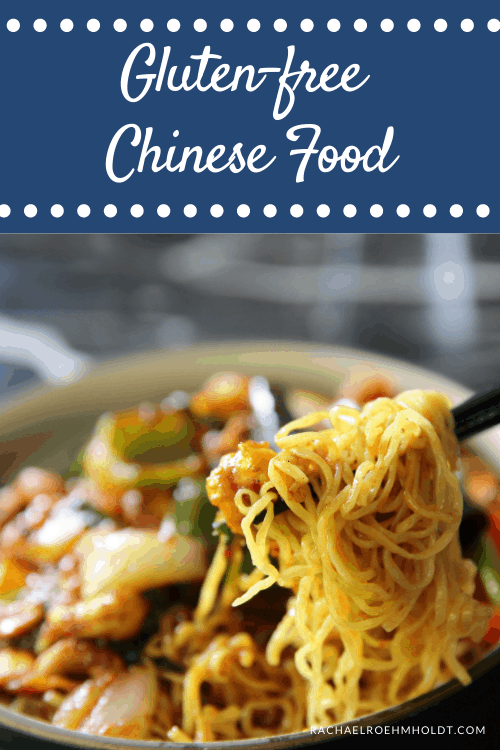
Note: I am a proud Amazon, Chomps, MunkPack, and Thrive Market affiliate and am happy to recommend their service and products to you. Please know that as an affiliate, I may receive a small commission on the products you purchase after clicking through my links. For more info, please see my disclosure policy here.
If you’re tired of wondering what foods you can enjoy on a gluten-free diet at Chinese restaurants, you’re not alone. With so many breaded foods and options made with soy sauce, there’s a lot of different variables to consider. So whether you have celiac disease or a gluten intolerance, let’s find out what foods you can enjoy and those you’ll want to avoid while being gluten-free.
It can be tricky to find Chinese dishes from restaurants that are gluten-free, but with these tips and strategies, I hope to help you make decisions next time you’re ordering to help you stick with your gluten-free diet.
In this post, we’re going to dive into some tips on finding gluten-free dishes, how to talk to your waiter about your gluten-free needs, and some generally gluten-free safe options.

Is Chinese Food Gluten-free? Does Chinese Food Have Gluten?
For a quick and simple answer, a lot of Chinese dishes and Chinese cuisine is not gluten-free.
There are plenty of places that gluten and gluten-containing wheat flour can show up in many Chinese food dishes, like breading on meats, soy sauce, egg noodles, and all brown sauces like teriyaki, fish sauce, or duck sauce, etc.
You’ll also want to be aware of cross contamination between ingredients that contain gluten and those that don’t, as well as the pots that they’re cooked in.
Unless you are at a Chinese restaurant that specifically shares with its customers that it uses gluten-free ingredients and their food is made in a dedicated gluten-free kitchen, folks with a gluten allergy or need to avoid gluten for their dietary needs should proceed with caution.
If you do happen to find a Chinese restaurant that offers gluten-free ingredients, be sure to find out what flours and thickeners are used. Some folks may not truly understand what “gluten-free” means before marketing themselves that way.
If you get answers like rice flour, tapioca starch, or potato starch for what they use as thickeners or in their noodles or breading, these are all gluten-free ingredients and safe for you to enjoy on a gluten-free diet.
However, that doesn’t mean that there are no options for a gluten-free diet. Let’s go over some tips on what and how to order.
Tips for Ordering Gluten-free Chinese Food
If you have Celiac disease, it will likely be challenging to feel comfortable finding things on the restaurant menu that offers Chinese cuisine that will be safe for you.
Chinese restaurants are not going to be a gluten-free eater’s best friend – let’s get that out of the way right away.
However, the good news is that there are some things folks with gluten intolerances can do and things to be aware of to make it not a total disaster.
Here are some things to keep in mind next time you find yourself at a Chinese restaurant.
Bring your own soy sauce
Most Chinese restaurants use a traditional soy sauce made with wheat. You’ll want to avoid dishes made with regular soy sauce and other dark sauces.
You can bring along a bottle of gluten-free tamari soy sauce or coconut aminos to add to the dish after it’s been cooked.
Or offer it to the cooks and ask if they will use this in place of the traditional soy sauce they normally use to make it gluten-free.
Sriracha sauce is gluten-free and combined with gluten-free tamari soy sauce is an excellent sauce on many dishes.
Read on: Is tamari gluten-free?
Read on: Is soy sauce gluten-free?
Read on: Is soy gluten-free?
Read on: Top 5 Gluten-free Soy Sauce Brands
Read on: Is Sriracha gluten-free?
Be aware of dark sauces
Avoid dark sauces on most Chinese dishes, as these often contain gluten and wheat. Fish sauce, duck sauce, oyster sauce, teriyaki sauce, hoisin sauce, etc all contain gluten, unless specific gluten-free brands are used.
Instead ask for simply cooked meat and vegetables or rice and rice noodles or a dish with a “white sauce” made from cornstarch, but no soy or dark sauces.
Read on: Gluten-free Teriyaki Sauce
Read on: Is teriyaki sauce gluten-free?
Read on: Is hoisin sauce gluten-free?
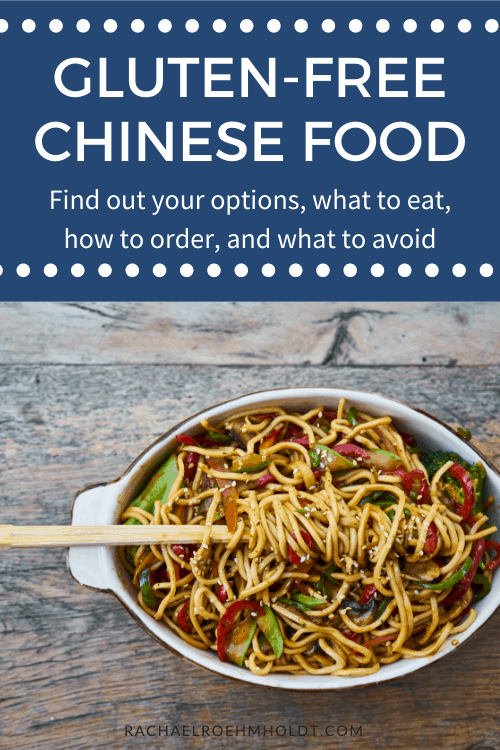
Be wary of sharing dishes at the table
If you’re the only one at the table who needs to eat gluten-free, be aware of the other dishes at the table.
It’s traditional to share dishes among the table when enjoying Chinese food, but be sure to use dedicated spoons for each bowl or dish if others want to share.
This will help prevent gluten from going from one dish into your gluten-free dish, cutting down the opportunity of cross contamination.
Cross Contamination is Almost Guaranteed
I hate to be a Debbie Downer, but the truth of ordering Chinese food is that you’re more than likely going to encounter cross contamination of gluten somewhere along the way.
Even if you can get a dish ordered without soy sauce or dark sauces, and you choose all the right ingredients, cross contamination will likely still happen.
For a dish to be completely gluten-free, you’re going to need a dedicated wok and cooking utensils that haven’t come in contact with other gluten-containing ingredients.
At home, this isn’t a big deal, but when you’re at a restaurant, it can be pretty tricky to convince a cook who isn’t used to cooking this way to make an exception just for you.
You may be lucky and have a restaurant near you that’s very attentive to people with gluten-free needs, and that’s great!
For the rest of us, be aware that it’s quite likely that you will come into contact with gluten at some point while eating at a Chinese restaurant, unless you eat only plain rice.
If you’d like to learn more about taking on a gluten and dairy-free diet, I highly recommend checking out The Gluten and Dairy-free Diet: A Beginner’s Guide. You can find more information on that here or below.
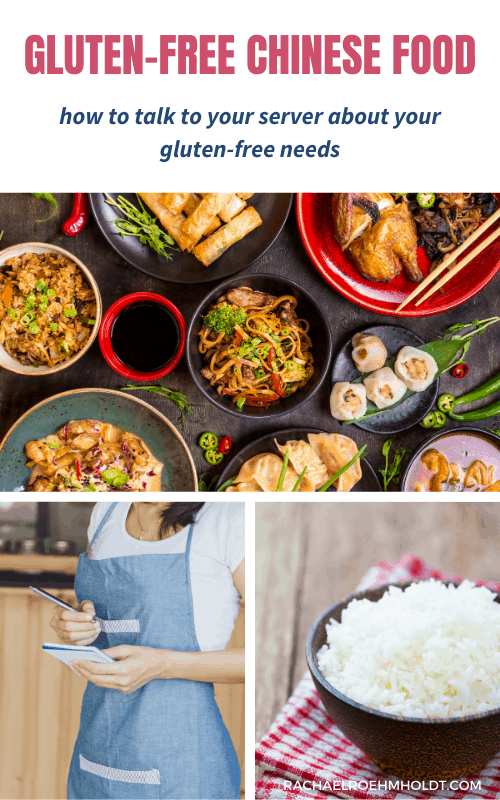
How to talk to a server about your gluten-free needs
The best way to discuss your gluten-free needs with a waiter or server is to try to speak with someone who speaks your language fluently and understands your requests. If they aren’t available, ask what member of the restaurant staff might help you get your questions answered.
When you’re sure you can communicate effectively, explain that you need to find gluten-free options and ask for a gluten-free menu.
If there isn’t one available, you may want to ask them to point out on the menu which dishes use rice or rice noodles and no soy or dark colored sauces.
Read on: Is white rice gluten-free?
Another great way to communicate with your server is to bring a gluten-free restaurant card with you.
I found some great ones from Celiac Travel and they even have an app called Gluten Free Restaurant Cards to help you share your needs in different languages. You can show it to them so they can speak with the cooks about your options.
One other strategy I use is to look at menus online before I head out to a restaurant. This feels important to me, so I have time to review what my options are and take my time figuring out if there’s a possibility that I can make it work.
I know it doesn’t sound very spontaneous, and it’s quite boring to know exactly what you will order before you even step foot in a restaurant, but when you have dietary restrictions, that’s the name of the game.
Look ahead to be prepared or find another restaurant to go to.
Read on: Gluten-free restaurants and menu items
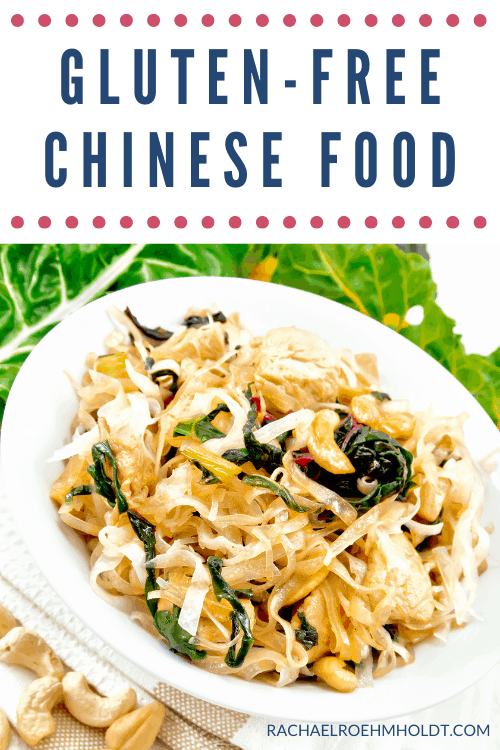
Gluten-free Chinese food
While these dishes aren’t always considered gluten-free (it will depend on where you go and what ingredients are used), these are some options that you can review on a menu and determine if they will be gluten-free.
As always, ask your server for details before ordering.
Rice and Rice Noodles
Dishes made with rice (plain white or brown) or rice noodles are generally safe, as rice is naturally gluten-free.
Chow fun (wide noodles) and mei fun (thin noodles) are both great options. Assuming the dish doesn’t contain any dark sauces or soy sauce, rice and rice noodles are safe.
Read on: Are Rice Noodles Gluten-free?
Read on: Is Rice Gluten-free?
Read on: Gluten-free Ramen Noodles
Soba or Glass Noodles
Soba noodles (made from buckwheat) and glass noodles (made from mung beans or starches like potato, tapioca, or green pea) are generally considered to be gluten-free.
Read on: Is buckwheat gluten-free?
Read on: Is buckwheat flour gluten-free?
Read on: Are soba noodles gluten-free?
Read on: Are glass noodles gluten-free?
Simply Prepared Meats and Vegetables with Tamari Soy Sauce
Dishes that come with plain meat or vegetables are also generally gluten-free. Look out for dishes with dark sauces, as they often contain gluten.
You may consider ordering simply prepared noodles, vegetables, and meat, then adding your own gluten-free tamari soy sauce or sriracha sauce to the meal.
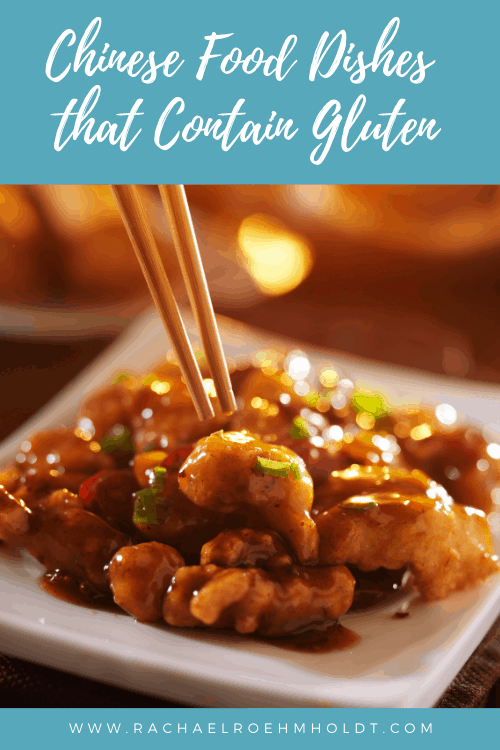
Chinese Dishes that Contain Gluten
When you’re trying to avoid gluten, be on the lookout for these different types of dishes on the menu as they very likely contain gluten or wheat.
- Anything with soy sauce, unless made with gluten-free tamari soy sauce
- Anything with dark brown sauces (fish sauce, oyster sauces, teriyaki sauce, duck sauce, etc)
- Chow mein noodles
- Fried rice made with soy sauce
- Breaded meats or other breaded food
- Sweet and sour chicken
- Noodles made from wheat (ramen, udon, mein)
- Dishes made with broth
- Egg rolls and dumplings
- Egg drop soup
- Fortune cookies
Read on: Are egg rolls gluten-free?
Read on: Are udon noodles gluten-free?
Read on: Is fried rice gluten-free?
Read on: Is egg drop soup gluten-free?
Read on: Are spring rolls gluten-free?
Read on: Is chow mein gluten-free?
Read on: Is lo mein gluten-free?
As you can see, eating gluten-free Chinese food isn’t impossible, but it certainly comes with a lot to think about.
There are options for you, and you’ll want to do your due diligence in talking to your server, reviewing menus, and asking for dishes to be made without soy sauce.
The very best way to make sure the Chinese food that you are eating is gluten-free is to make your own at home.
No, it’s not as easy as picking up the phone for takeout or walking into a restaurant, but it’s the simplest way to be sure you can eat something delicious that suits your body’s needs.
If you have any great tips on ordering Chinese food at restaurants, be sure to share them in the comments section!
Love this post? You might also want to check these out!
Looking to learn more about a gluten and dairy-free diet? Check out these posts!
Going Gluten and Dairy-free for Beginners: Top 10 Tips
Are you just starting out going gluten and dairy-free? Check out these top 10 tips for going gluten and dairy-free for beginners.
What foods are naturally gluten and dairy-free?
What foods are naturally gluten and dairy-free? This post will tell you the 7 types of foods that are safe on a gluten and dairy-free diet.
What is Gluten in Food? The Basics of a Gluten-free Diet
Find out what exactly gluten is, what gluten-free means, the foods you can eat on a gluten-free diet, and many more commonly asked questions related to going gluten-free.
Other Names of Gluten & Where They Hide Most
Learn about the other names of gluten that many people don’t know about and the surprising places they hide in different foods.
26 Hidden Sources of Gluten in your Kitchen
Are you just getting started with a gluten-free diet? If so, you won’t want to miss these 26 hidden sources of gluten in your kitchen!
What's the difference between dairy, lactose, casein, and whey?
Find out the difference between dairy, lactose, casein, and whey in food.
26 Hidden Sources of Dairy in Your Kitchen
Dairy-free diet beginner? Learn the 26 hidden sources of dairy that may be hiding in your kitchen.
Dairy-free Milk Alternatives + How To Choose What's Right for You
Are you dairy-free? Not sure what you can drink instead of milk now? Check out this list of dairy-free milk alternatives including the pros and cons of six popular drinks AND how to choose the best one for you.









